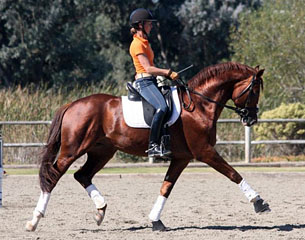
With a total of 65 horses currently in work at their stable in California, Shannon and Steffen Peters have spent their lives training young horses all the way to Grand Prix level. Though an established Grand Prix rider and considered one of the world's top five GP riders, Peters has not said adieu to the challenge of bringing on rambunctious youngsters to mature FEI level horses.
"I've spent most of my riding career bringing four and five year-old young horses through the levels to Grand Prix.To me there is no greater reward than spending six or seven years with a horse until they're confirmed at the highest level, and can go out and produce their very best," three time Olympian Steffen Peters told Eurodressage.
Teaming up with wife Shannon Peters, the couple established the US training facility Arroyo Del Mar, where the two ride a total of 20 horses a day, while the other 45 are worked by other trainers, who are lucky to ride in the heart of the Californian action.
With a 50/50 ratio of young, to more experienced horses, Shannon says that the ratio of young horses that make it all the way to GP is typically around one in ten, but of course that all depends on the horses. "I wouldn't say that we find any one part of training a horse to GP particularly "hard", as we both find great enjoyment in training a horse from start to finish, no matter how far that horse manages to excel," she said. "The reward for us is in the journey, and the relationship you create with each and every horse."
Certain that Udon is the best young horse the couple have ever brought on to GP level, Steffen recited that his parents bought the horse as a 3-year old and together the pair went all the way to the Olympics.
 "For me Flor de Selva is my greatest young horse," Shannon said about the former PSI auction horse. "He has the biggest personality, and to this day, he puts a smile on my face every time I ride him!"
"For me Flor de Selva is my greatest young horse," Shannon said about the former PSI auction horse. "He has the biggest personality, and to this day, he puts a smile on my face every time I ride him!"
Acknowledging that it is hard to say if a horse wins at the young horse competitions, he will be a success in GP level, Shannon has learnt from experience that it really comes down to the two big P's! "You cannot really tell whether a young horse will make it until you start training the piaffe and passage and confirming the one tempi changes. Only then do you really "know" a horse will have success at the GP level."
Shannon knows there are many reasons why a horse might not make it to GP and that each individual horse poses his own unique challenges. "So many things have to be correct in the horse's foundation. Soundness becomes a factor, fitness, and strength levels, and the ability to remain happy in their work," she said.
Despite the long and difficult journey from youngster to GP, neither Shannon nor Steffen have an age or ability preference when it comes to training horses. They manage to find joy in each small accomplishment. "A 4-year old can just as easily put as big a smile on my face as a horse confirmed in the GP," she admitted.
 Searching for rideability and self carriage in a potential GP level horse, Shannon likes to feel if the horse can react to the softest aids, while also having that something extra in the mind! "The reason why Flor De Selva was my greatest ever horse to train, was because if it were possible for a horse to offer 150% every day, he would do it," she said. "For Steffen, it would have to be Ravel for his willingness and generosity, both qualities that he held "beyond compare."
Searching for rideability and self carriage in a potential GP level horse, Shannon likes to feel if the horse can react to the softest aids, while also having that something extra in the mind! "The reason why Flor De Selva was my greatest ever horse to train, was because if it were possible for a horse to offer 150% every day, he would do it," she said. "For Steffen, it would have to be Ravel for his willingness and generosity, both qualities that he held "beyond compare."
With a few horses that didn't really peak until their teens, Shannon knows that there is no real timeline for training progression, but there are some things that you can see early on. "You can for sure look at a two year old and see his future potential. You can see already the great movement. However, you really don't know until you sit on them, what they can produce in the future."
All in all it comes down to spotting the key three (rideability, movement, self carriage) and then training that horse according to his or her own strengths and weaknesses, until hopefully one day, they take the GP centreline. "The introduction of new movements and training patterns all depends on the horse. Some horses do easy changes at four, some horses need more time to find their balance in the canter. We approach each horse as an individual and train accordingly. But the most important thing to remember is the horse always tells you what he needs, and when he is ready, if you are willing to listen!"
by Sarah Warne for Eurodressage
Related Links
Catherine Henriquet on Training the Young Horse up to Grand Prix
Laura Bechtolsheimer Taking her Time with Young Horses
Cur-OST, Revolutionary Inflammation Protection